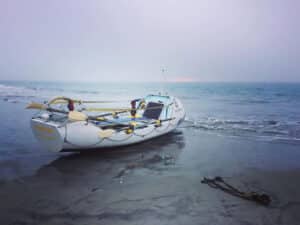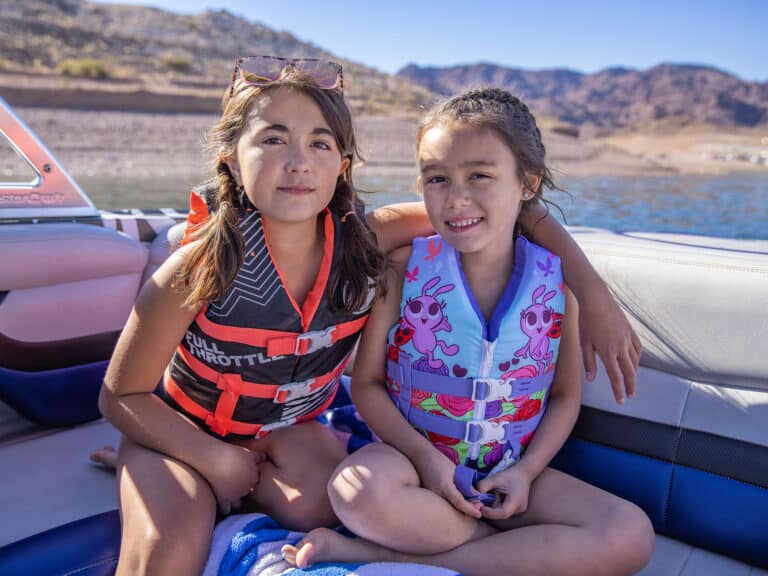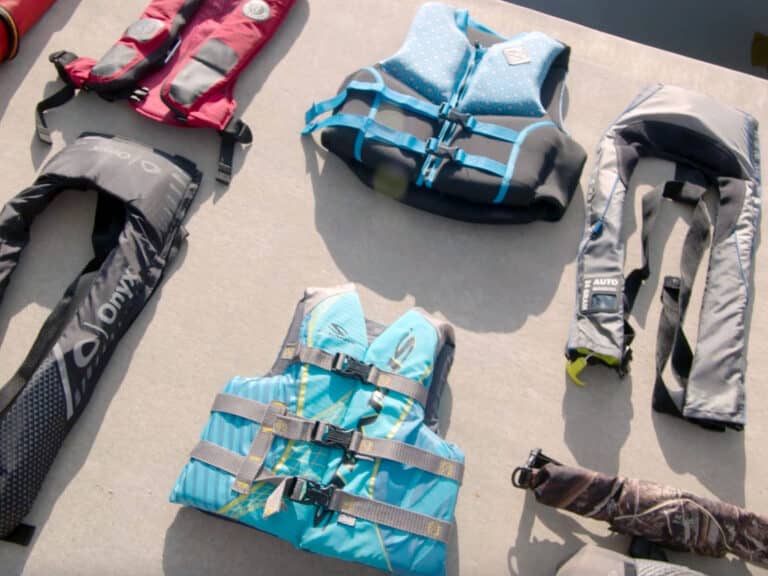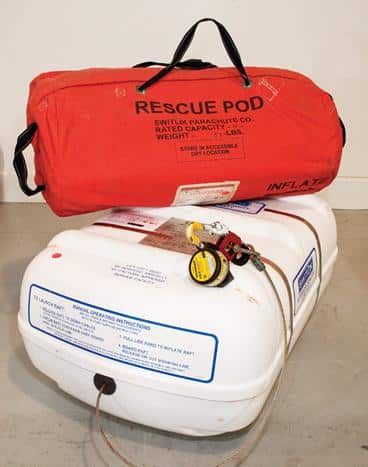
A life raft is the last piece of equipment boaters ever expect to use. After everything else has failed — bilge pumps, fire-suppression systems and the skipper’s best efforts to save the boat — the crew turns to the raft, likely never to see that boat above water again. In hindsight, shipwreck survivors wish they had more or better equipment when they abandoned ship, but the same can be said about insurance. Human nature is to spend less on things one never intends to use. Consider too that a new chart plotter or better radar might prevent a catastrophe. For many it comes down to a choice of how to spend that $2,000 or $3,000. With that in mind, we asked two life raft sales and service experts for frank advice on choosing a raft.
“I can eliminate 90 percent of the choices with just two questions: What kind of boat do you have, and where are you going?” says Brian Bohne, manager of Inflatable Services and 84 Boatworks in Fort Lauderdale, Florida (84boatworks.com). The first question seems odd, but Bohne says it’s often the most important. “I’d rather they have a less-expensive raft they can get to than the best raft in the world that will burn or sink with the boat,” Bohne says. This often means choosing a smaller or lighter raft with fewer features but that fits in a locker somewhere near the helm. A raft on the bow or atop the hardtop might be out of the way, but Bohne warns either is nearly impossible to reach in rough seas on a foundering boat. Storing a raft near the stern doesn’t take into account the most likely source of a fire. “If you have to go across the engine room hatch [to reach your life raft], that’s a bad idea,” he says.
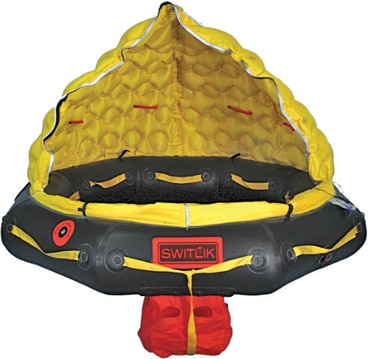
When space is tight, Bohne often recommends a coastal raft or even a bare-bones rescue pod supplemented with an EPIRB and a simple ditch bag, both within arm’s reach of the helm. But his second question also plays strongly in his suggestions. “The more remote you get, the longer it’s going to take for rescue,” Bohne warns. Five miles from Florida is a lot different than five miles from the coast of an island in the Bahamas, the latter requiring a raft better able to handle weather and packed with more survival equipment. Even when cruising within a few miles of shore, it may be many miles between inlets safe to traverse in a storm, so raft stability becomes important. Cold water calls for a raft with an inflatable or insulated floor to prevent hypothermia.
Bohne points to European-made EV or Revere rafts as among the most compact. Mark Haskell, owner of A Sailor’s Place in Stuart, Florida (www.asailorsplace.com) adds Zodiac to that list. “They’re reasonably priced and a good value,” Haskell says, but all three brands are made of PVC rather than rubber. For longevity, Haskell likes neoprene best, natural rubber second and PVC last. Bohne disagrees, though. “A PVC life raft with 100 percent welded seams is the longest-lasting life raft you can buy,” Bohne says. “There is no direct ultraviolet exposure [to a life raft], so it’s usually the glue that fails. With 100 percent welded seams, there is no glue to degrade.”
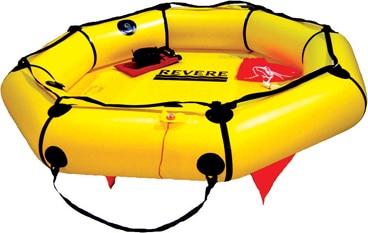
Bohne’s caveat — all-welded seams — is important. Both he and Haskell report problems where some manufacturers of welded-seam rafts glue on ballast bags or canopies. “If the ballast bags come unglued, the raft [might capsize],” Haskell says. “If the canopy comes unglued, you don’t have protection from the sun.” Both Haskell and Bohne say annual inspections head off such problems, but both are concerned with the trend toward three-year service intervals. To extend time between inspections, rafts are sealed inside a vacuum bag. While this helps keep moisture out, “The heat seal on a vacuum bag can come apart, or the raft can shift and pinch it,” Haskell says. “Once moisture gets inside the bag, you get corrosion on metal fittings and mold and mildew, which break down the fabric. When glue sits in water and heat for years, it softens.”
Extending service intervals does save money — about half the cost at roughly $1,200 for three years versus $800 per year for annual service over those first three years, with less of a difference at the end of six years.
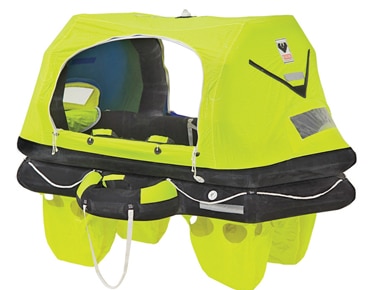
To head off potential problems between inspections, Haskell suggests storing rafts inside during winter layup and finding a mounting location where it won’t be baked by direct summer sun. Bohne suggests periodically opening the Velcro of valise storage containers to look for signs of water in the vacuum bag or tipping fiberglass raft canisters on their sides to see if water comes out of canister seams. “If you’re holding water inside that vacuum bag and you wait three years [for inspection], that raft is ruined.” Bohne says. He also worries about flashlight batteries and repair kit glue. “Having those items in your ditch bag becomes much more important.”
Features like boarding ramps rather than web ladders add to raft cost but are important considerations. “If you can’t get into a life raft, it does you no good,” Bohne says, pointing out that raft freeboard may be 24 inches high. He says there is no substitute for seeing equipment while contemplating which features fit individual cruiser’s needs and scrutinizing differences between manufacturers in raft and survival gear quality.
“You wouldn’t buy a boat without looking at it. Why would you buy a life raft without seeing it first?”
Sometimes Bohne sells less raft than a customer originally intended. Other times the opposite is true. “When you’re 500 miles away from anything, you have to be self-sufficient,” Bohne says. “If you don’t have the budget, let’s find you a used raft or find some other way. I try to make sure they walk out the door with the raft they need.”
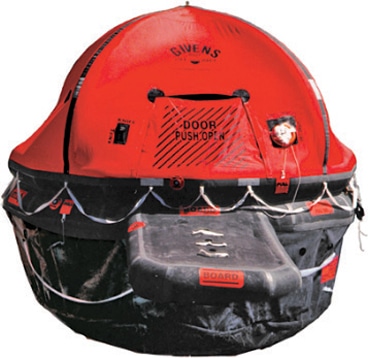
Raft Choices $1,000 to $2,500: Not quite life rafts, rescue platforms or compact rafts are a recent trend intended simply to get survivors above the water. Canopies are options, but all have rudimentary ballast systems. With no equipment, an EPIRB and a basic ditch bag are critical.
$1,700 to $6,000: Coastal life rafts offer a safe haven when quick rescue is expected. Typically with just one floatation tube and small ballast bags, they aren’t intended for rough water. Most have self-deploying canopies and all have basic signaling and survival equipment.
$2,800 to $10,000: Offshore rafts offer better ballast systems — Switlik and Givens are considered the best. All offshore rafts ride on two inflated tubes for higher freeboard and redundant flotation, which also helps in rough water. They include more survival gear than coastal rafts.
Options that increase the price of both coastal and offshore rafts include inflatable or insulated floors to prevent hypothermia in chilly water and boarding ramps instead of web ladders, a definite consideration for all but the most physically fit.
Weather or Not?
While 406 MHz EPIRBs quickly notify rescuers of distress, weather may hinder rescue, and nasty weather doesn’t require extended ocean passages. In 1980, a tropical wave near Africa on Aug. 1 became fast-moving Hurricane Allen on Aug. 2 and intensified to Category 5 strength south of Puerto Rico by Aug. 4. Caught unexpectedly near Jamaica, the crew of the 48-foot Island Princess took to their Givens raft (shown to left) in 190 mph winds and 35-foot seas, miraculously never capsizing even right through the eye of then the most powerful Atlantic hurricane on record. A coastal or lesser offshore raft wouldn’t have faired as well. Consider too that stability and warmth come from filling a raft near its rated capacity, so don’t buy too large a raft for offshore voyages.
The U.S. Coast Guard is asking all boat owners and operators to help reduce fatalities, injuries, property damage, and associated healthcare costs related to recreational boating accidents by taking personal responsibility for their own safety and the safety of their passengers. Essential steps include: wearing a life jacket at all times and requiring passengers to do the same; never boating under the influence (BUI); successfully completing a boating safety course; and getting a Vessel Safety Check (VSC) annually from local U.S. Coast Guard Auxiliary, United States Power Squadrons(r), or your state boating agency’s Vessel Examiners. The U.S. Coast Guard reminds all boaters to “Boat Responsibly!” For more tips on boating safety, visit www.uscgboating.org.




